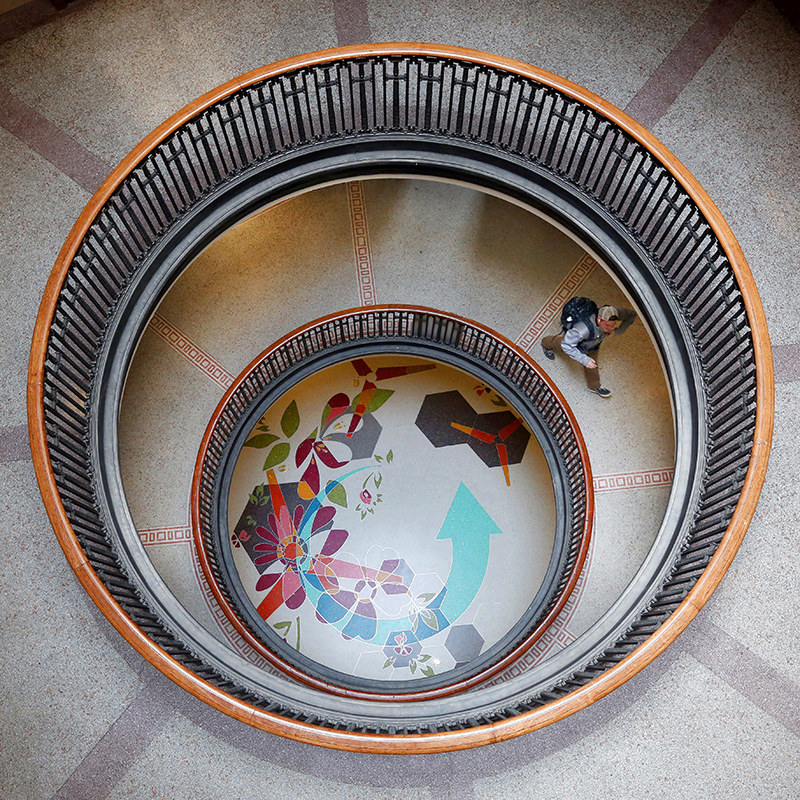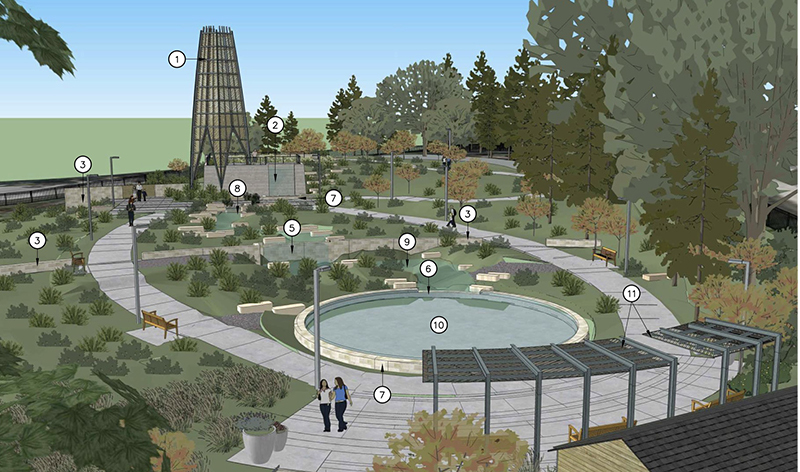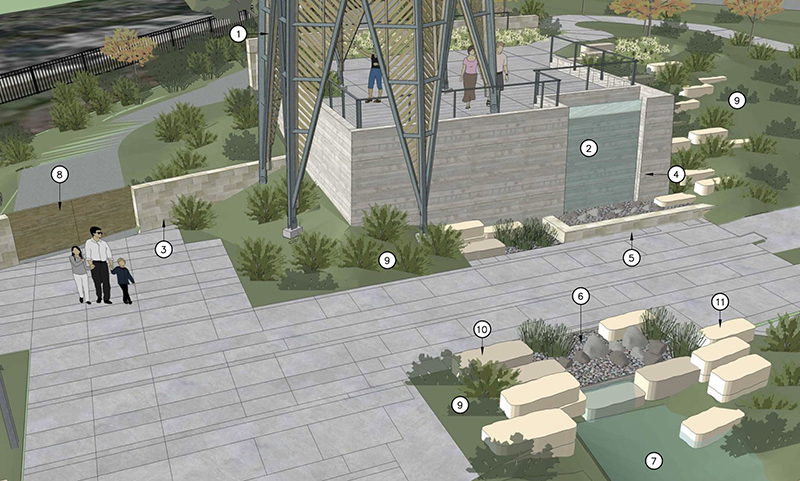Campus tour features public art often overlooked

"All the Way Home," a 25-foot-wide terrazzo mosaic installed in the floor of Curtiss Hall during its 2013 renovation, is one of the subjects of a university museums art walk next week focusing on public art that often goes unnoticed on campus. Photo by Christopher Gannon.
A stroll across campus is bound to cross paths with Iowa State's extensive collection of public art. It might even walk right over it.
The June version of the monthly art walk hosted by university museums will explore elements of the art on campus collection that are hidden in plain sight, including a piece people step on every day. The walk starts on the ground level of the Curtiss Hall rotunda, where a 25-foot-wide terrazzo mosaic titled "All the Way Home" was installed in the floor during a renovation completed in 2013.
The numerous mosaics in floors and walls on campus inspired Erin O'Malley, campus outreach coordinator for university museums, to highlight Iowa State artwork that's easy to overlook because it's embedded in buildings or functional structures. Another stop on the tour, for instance, is a gate.
"When people think about the public art on campus, they think about the large sculptures. But we have so much art that is integrated into buildings, pieces of art that are made up of many different components throughout a building, things that are in floors and walls," O'Malley said. "It's not as flashy as people might think. A lot of times, it's not really noticed."
But it's worth noticing, she said. "All the Way Home" is one of the most colorful mosaics on campus, with bright abstract shapes and images suggesting the growing cycles and technological advancements of agriculture. During the art walk, which begins at noon June 13, her presentation will explore why artists used the spaces in question and what they were trying to say.
"The focus is really to make people stop and consider things that they didn't consider to be works of art," she said.
Steps to understanding
Consideration of the art around us is the goal of every month's art walk. The free hourlong tours -- new each month, no reruns -- interpret aspects of the art on campus collection for students, employees and community members. In addition to providing a more intimate recognition of the university's public art collection, the walks help boost visual literacy, O'Malley said.
"It's teaching people how to look at art and analyze it. It's a useful skill to have," she said.
Art walks are held on Wednesdays over the lunch hour to make it easier for faculty and staff to participate, O'Malley said. Each walk takes stock of about a half dozen pieces within walking distance that speak to a certain theme. Here are the other walks planned through December and their meeting locations:
- July 11, A whirlwind of art, Agronomy Hall
- Aug. 22, An artful welcome, Food Sciences Building
- Sept. 19, A journey with art, MacKay Hall
- Oct. 24, Mystery and surprises, Molecular Biology Building
- Nov. 14, A luminous sight, Marston Hall
- Dec. 5, A celebration in art, Music Hall
IPERS contribution rate to increase in July
Employees whose retirement plan is through the Iowa Public Employees' Retirement System (IPERS) will see an increase in their contribution rate in July.
The contribution rate for employees who are IPERS members will increase to 6.29 percent, up from the current rate of 5.95 percent. That means an additional 0.34 percent of their paycheck will automatically divert to IPERS. For an employee with an annual salary of $60,000, for example, the contribution to IPERS would increase $17 per month.
The employer contribution also is increasing, up to 9.44 percent from the current rate of 8.93 percent.
Contribution rates are different for IPERS members in protection occupations, including some officers with ISU Police. The employee contribution rate for protection occupations will increase to 6.81 percent from 6.56 percent.
The increases are effective for any wages received on or after July 1, so employees paid twice monthly will see the change in their mid-month paycheck on July 13. For employees paid monthly, the new rate will kick in on the July 31 paycheck.
"If employees have any questions they should contact the UHR benefits team by phone at 294-4800 or by email at benefits@iastate.edu," said Ed Holland, UHR benefits director.
Contribution rates are set annually by IPERS, based on an actuarial valuation. Rates can't increase or decrease by more than 1 percentage point per year. The new rates are in place through June 30, 2019.
IPERS, a public defined-benefit pension plan, is one of two retirement plans available to Iowa State employees. When hired, faculty and staff elect to contribute to either the IPERS plan or a defined contribution 403(b) plan offered through TIAA.
Marcketti will lead teaching center

Sara Marcketti
Sara Marcketti has been named director of the Center for Excellence in Learning and Teaching (CELT).
Marcketti, professor of apparel, events and hospitality management (AESHM), has served as CELT associate director since 2013 and interim director since July 2017. Her five-year appointment will extend through June 2023.
"Sara has demonstrated outstanding leadership during her year as interim director, leading CELT through a successful external review, and overseeing the university’s transition from Blackboard to Canvas," said Dawn Bratsch-Prince, associate provost for faculty. "She is also an accomplished educator in her own right, with a strong focus on the scholarship of teaching and learning, and is a passionate advocate for student success."
Marcketti is active on numerous campus initiatives through her faculty and CELT roles. She leads workshops on documenting teaching effectiveness, turning scholarly teaching into the scholarship of teaching and learning, and student engagement and active learning strategies.
"It has been my honor and pleasure to lead the CELT staff this year," Marcketti said. "We have much to celebrate and I look forward to working with the CELT staff to ensure our workshops, programs and resources continue to provide the support instructors need along their teaching trajectory."
A native of New York, Marcketti joined the AESHM faculty in 2005. She holds a bachelor's degree in art history and a master's degree in textiles, merchandising and interiors from the University of Georgia, Athens. She earned a Ph.D. in textiles and clothing from Iowa State. Marcketti was named a fellow of the Costume Society of America earlier this year, the highest recognition awarded to faculty in her discipline.
Sycamore Falls headed toward fall completion

This image from construction documents depicts many of the features of the new Sycamore Falls garden in the southwest corner of Reiman Gardens. Submitted image.
Construction resumed this spring on the Sycamore Falls garden in the southwest corner of Reiman Gardens. If work stays on schedule, the garden will be completed by early December.
The design takes advantage of the land's natural slope and features water cascading about 20 feet down a series of limestone walls to a reflecting basin. The stream water will come from a contained system that's turned off during the cold weather months.
At the top of the falls will be a viewing deck to provide a one-of-a-kind angle on all of Reiman Gardens to the north and east, said construction manager John Boehmer, facilities planning and management. Ornamental plants and rocks will flank the falls. Rising more than 40 feet above the deck will be a six-sided, asymmetrical tower structure, built in part with wood from the university's TreeCycle program, which repurposes wood from downed campus trees.
Adjacent to the reflecting pool will be a pergola shade structure and beyond it, a small restroom building. A boardwalk will connect Sycamore Falls to the Town and Country Garden to the northeast. A paved path will ring the water feature.
The garden is named for the seven 80-year-old sycamore trees that form its natural east border. Sycamore Falls is part of the gardens' 2015 master plan. The $3.4 million project is being funded with private gifts, including a $1.7 million lead gift from Roy and Bobbi Reiman, for whom the gardens are named.

This construction image shows the viewing deck and tower base at the top of Sycamore Falls. Numbers 2 and 7 represent water; 6 marks the stream source. Submitted image.
